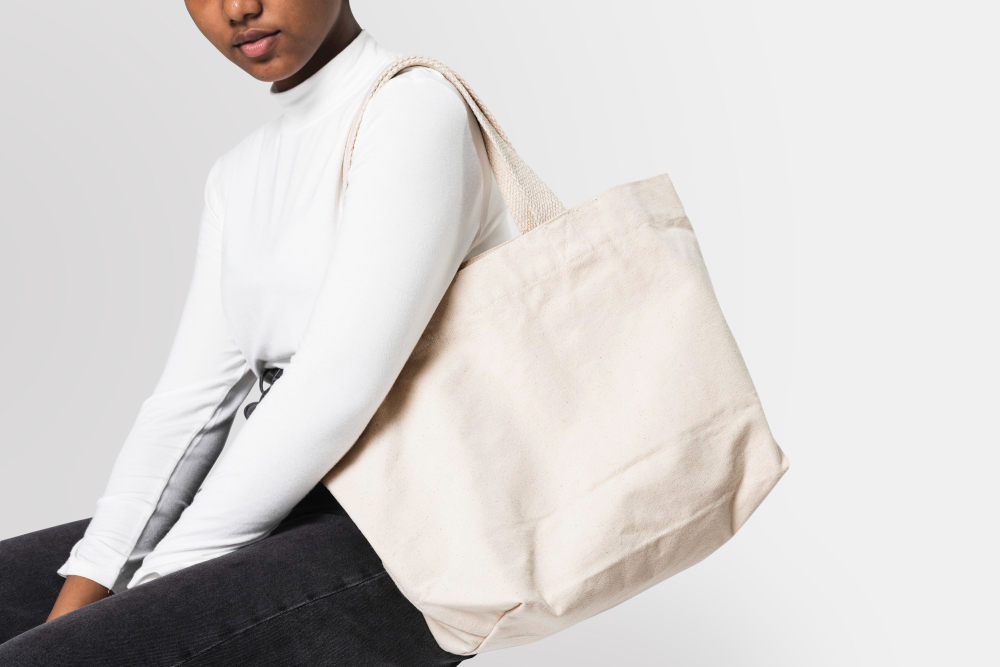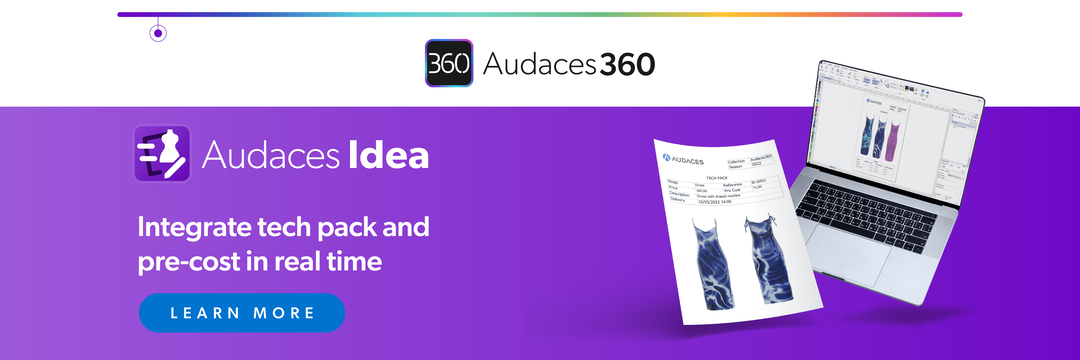Summary
- Creating a perfect tote bag pattern requires attention to detail and thoughtful construction techniques.
- These tips will help you avoid common mistakes, improve your workflow, and achieve professional, functional designs.
- Want to take your pattern making skills to the next level? Subscribe to our newsletter!
The tote bag is a timeless fashion staple that’s here to stay. Creating its pattern may seem simple at first glance. But achieving a perfect fit, balance, and functionality requires careful planning and attention to detail.
Whether you’re designing for a client or your own collection, even minor errors can affect the final product. A well-developed pattern ensures that your tote bag looks professional while maintaining durability and functionality in everyday use.
In this blog post, we will share five practical tips to help you create a tote bag pattern with precision and confidence.
We hope you enjoy your reading!
Sumário
Why is it essential to create a tote bag pattern correctly?
A tote bag may look like a simple accessory, but its success depends on the accuracy of the pattern behind it. A poor pattern can lead to issues such as uneven seams, distorted shapes, or weak handles that compromise durability.
Creating a correct tote bag pattern also helps streamline the production process. With a clear and accurate base, you avoid unnecessary adjustments during sewing, saving both time and material.
This efficiency becomes even more important when producing in larger quantities, when you risk multiplying every mistake.
Another reason to focus on proper pattern creation is consistency. Whether making one tote bag or one hundred, a good pattern ensures each piece has the same dimensions.
5 essential tips for creating a tote bag pattern
To achieve a professional result, it’s not enough to simply sketch a basic tote shape.
Below are five practical tips that will help you design tote bag patterns that are functional and visually appealing.
1) Understand the style you want to achieve
Before starting the pattern, it’s important to understand the designer’s vision. A casual everyday tote, for example, has different requirements compared to a structured fashion piece or a reusable bag.
Knowing the purpose of the bag will guide your decisions on size, construction, and details.
Style also influences the overall aesthetic. Do you want a minimalist tote with clean lines, or a decorative one with pockets, flaps, or embellishments? Understanding the desired style helps you set a clear direction before drafting the first line on your pattern.
2) Pick the right material for your design
The choice of fabric is just as important as the pattern itself. A lightweight cotton may work well for a casual tote, while leather or canvas is better suited for a structured, long-lasting bag. Each material has its own characteristics, and your pattern should reflect how the fabric behaves.
If you select a soft or thin fabric, you may need to add reinforcements, linings, or interfacing to ensure the tote holds its shape. On the other hand, with stiff materials, you must design seams and finishes that don’t add bulk.
These considerations impact the aesthetics, durability and comfort of the final piece.
3) Pay attention to measurements and proportions

Accurate measurements are the foundation of any good pattern. For tote bags, the width, height, and depth must be carefully matching the intended use.
A shopping tote, for example, requires more volume than a slim tote designed to carry documents or a laptop.
Proportions are equally important for balance and aesthetics. Handles that are too long or too short can make the bag uncomfortable to carry. An oversized body with tiny straps looks awkward, while the right proportions create harmony and functionality.
4) Design the pattern including all necessary details
Skipping details can lead to mistakes during cutting and sewing, which can waste time and material.
You must pay attention to even small elements like seam finishing or reinforcement points. For example, areas where straps attach to the body of the bag require stronger seams. Marking these reinforcements in the pattern ensures you won’t forget them.
5) Make a prototype and test the result
Even with a carefully designed pattern, creating a prototype is essential. A sample allows you to check proportions, fit, and structure in a real-life version. It’s a step that often reveals adjustments that aren’t visible on paper.
Testing the prototype also shows how the fabric behaves once assembled. You can verify whether the handles are comfortable, the bag holds its shape, and the seams resist weight. If something feels off, you can make corrections to the pattern before moving forward.
Discover how to create perfect patterns in just a few clicks with our complete ebook!
How can I create a tote bag pattern on my computer?
Digital solutions have transformed the way pattern makers design, test, and perfect their work. With the right software and workflow, you can go from idea to final print with confidence and efficiency.
Here’s a step-by-step guide:
Choose the software that fits your needs
Professional software designed specifically for fashion and accessories provides tools that make the process smoother. These programs include functions for accurate measurements, digital adjustments, and even 3D simulations.
Investing time in researching and testing different options is worthwhile.
Learn to use all its tools effectively
Once you’ve chosen your software, it’s important to learn how to use it fully. Many pattern makers only explore basic features, but mastering advanced tools can make a difference in speed and precision.
By becoming confident with the software’s potential, you’ll be able to create tote bag patterns more easily.
Collect all the measurements you need
Accurate measurements are the foundation of any pattern. Before starting the digital drawing, make sure you’ve gathered all dimensions required for your tote bag. They usually include width, height, depth, strap length, and any pocket placements.
Adjust and simulate the final product

One of the greatest advantages of digital pattern making is the ability to simulate the product before production. You can resize, reshape, or test different elements on-screen with just a few clicks.
Some advanced systems even allow you to visualize the tote bag in 3D. You can check its shape, proportions, and fit without cutting any fabric. This step is especially useful when testing new design variations.
Focus on details and finishing touches
Details are what separate a simple bag from a professional-quality tote. In digital pattern making, this means marking seam allowances, reinforcement points, and finishing details directly in your file.
These markings ensure you don’t forget anything when transferring the pattern to fabric.
For example, indicating where to reinforce the straps or add lining makes the assembly process faster and clearer.
Export and print the final pattern
The last step is to export your tote bag pattern in the correct format. Most software allows you to generate files suitable for printing, plotting, or even sharing digitally with manufacturers.
Before printing, check the settings to ensure scale and dimensions remain accurate.
Where can I learn how to create tote bag patterns online?

Software instructions
Most digital pattern-making systems come with their own set of instructions and learning materials. These often include step-by-step guides that explain how to use the software.
Many companies also provide video demonstrations, FAQs, and troubleshooting tips directly on their websites.
Online tutorials
Online tutorials are another great way to learn pattern making. Video platforms like YouTube offer content ranging from quick tips to full courses. These resources are flexible, allowing you to learn at your own pace.
Video tutorials are especially helpful because they show the process in real time. You can pause, replay, and practice as you go, which is perfect for visual learners.
In addition, many communities and forums share free tutorials created by professionals. These can give you practical insights and shortcuts that aren’t always in official manuals.
Audaces Academy
Audaces Academy is a dedicated platform designed to help fashion professionals and enthusiasts master digital tools, including pattern making. It offers structured courses that cover everything from the basics to advanced applications.
It combines videos, exercises, and expert guidance, making it easier to learn step by step. With content available online, you can access it anytime, anywhere, and revisit lessons whenever needed.
You will not only gain technical skills but also discover how to apply them to real production. It’s a valuable resource for anyone looking to grow in the fashion industry.
Bring your tote bag ideas to life with Audaces360!
Audaces is a market leader fashion technology company and a reference worldwide. Through a deep understanding of fashion creation and production, we have developed ideal solutions for each stage.
Audaces Pattern
Audaces Pattern is the perfect solution to simplify and speed up your pattern-making process. With intuitive digital tools and smart automation, you can create, edit, and grade patterns efficiently.
Save valuable time and can focus more on the creative and technical decisions that truly shape your collection.
When changes happen, you won’t have to start from scratch. The software makes it easy to adjust measurements, reshape pieces, and test new design variations with precision and speed.
To take it even further, Audaces Pattern integrates seamlessly with the full Audaces ecosystem. This connection allows you to plan, develop, and produce with consistency and accuracy across every stage.
Audaces 3D
Audaces 3D is ideal for pattern makers to bring creations to life in a 3D mannequin.
You can test your digital pattern before committing to a physical sample. Save time and resources by identifying issues early in the process.
With a range of tools and possibilities, this software transforms the development processes.
It enables you to shape your ideas directly in a digital space, gaining agility and quality in deliveries.
Discover Audaces360 and unlock a world of possibilities for fashion design and production. Explore our comprehensive suite of solutions today!
FAQ
The success of the tote bag depends on the accuracy of the pattern behind it. A poor pattern can lead to issues such as uneven seams, distorted shapes, or weak handles that compromise durability.
Choose the software that fits your needs, learn to use all its tools, focus on details and finishing touches, and export the final pattern.
You can learn from software instructions, online tutorials, and Audaces Academy.










